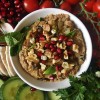Za’atar

Za’atar is the name for both a traditional Middle Eastern seasoning blend and the pungent green herb that gives the blend its intense, earthy character. The hardy herb, which grows wild, tastes like a combination of oregano, marjoram, summer savory and thyme — all of which can be used as substitutes if dried za’atar isn’t available.








